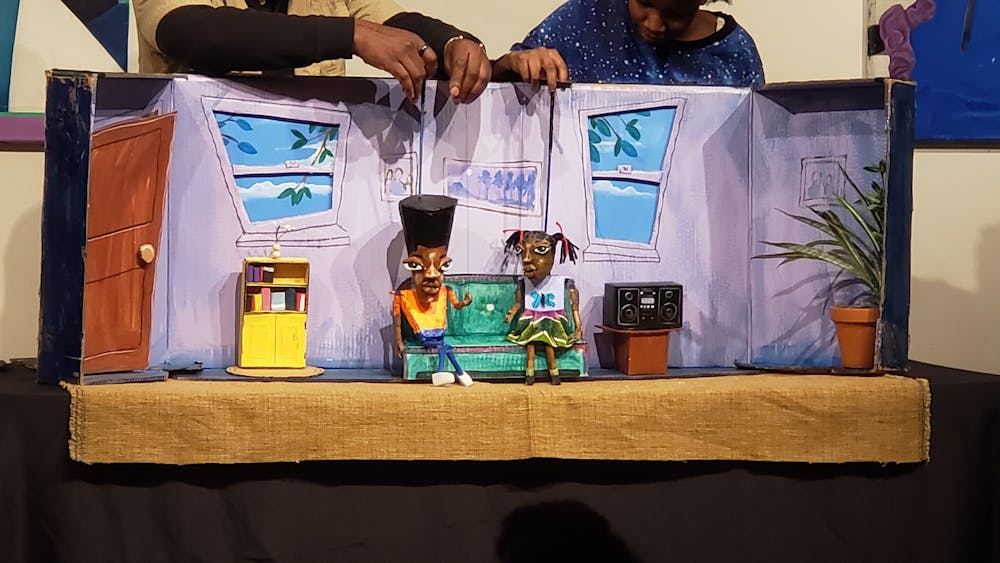After having only ever seen puppet shows in movies and on TV all my life, I, at the age of 21, finally saw one in person, and it was an utter joy. The show was put on by Baltimore-based troupe String Theory Theater (STT) and guest puppeteer Schroeder Cherry at The Eubie Blake National Jazz Institute and Cultural Center on Saturday, Jan. 26.
The first thing that struck me when I took a seat in the hall where the show was taking place was its welcoming atmosphere. Adorable antsy children had turned the back of the hall into a playground. It wasn’t a large production — a table stood in the middle of the room with a colorful set for the first skit.
The STT troupe itself is a family affair, composed of Dirk Joseph and his two teenage daughters, Koi and Azaria. The family gained its start at Baltimore’s Black Cherry Puppet Theater, which invites puppeteers of all ages and skill levels to perform at its puppet slams. Since then, the troupe has developed in skill and their love for the form and have been touring not only different locations in Baltimore, but also nearby cities and festivals.
The STT troupe and Schroeder Cherry were joined by William Emerson, better known as Abu the Flutemaker, who provided live music for the show. Abu, a Baltimore native, is famous for his one-man shows with his found-object instruments, which he has been handcrafting for decades. On this day, his instrument of choice was a saxophone made of PVC pipes and a plastic funnel.
The first performance titled, “Collab Story,” was about two siblings, Malik and Nafasi, sitting in a vibrant room, attempting to entertain themselves after their parents restricted their screen time. My favorite part of this performance was the aesthetic of the puppets and the sets. The cardboard and cloth puppets were made in an abstract art style, with almost Picasso-like faces, complete with sharp angular faces, large almond-shaped eyes that protruded out of their heads and deep vibrant colors. The set of the house was bright and had angular distortions that complemented the puppets beautifully.
After a short musical interlude by the Flutemaker, the troupe returned with a shadow puppet set. This skit told the story of the itsy-bitsy spider who made its way through the city and into a forest, where it spun webs in a tree and on everything that came its way. The spider’s journey through the city was made possible using a puppeteering contraption used for moving scenery called a “crankie,” which uses two rotating rods on both sides of the screen into which a long scroll with the scenery is fed.
The show’s guest puppeteer, Schroeder Cherry performed the next skit. His quite sassy puppet told the story of how the Sun was created in the Land of the Dark, where everyone carried their own little stars. The skit asked the audience to repeat a poem and imitate sounds. The very interactive nature had the audience, especially the children, enthralled.
The fourth skit took the form of an interview show in which a kitty, with the help of her producer, a dog, interviews different items around the house — toothbrushes, books and a roll of toilet paper (which dreams of being used for making paper planes instead). However, the kitty learns that her mother posted a video of her scratching a couch on YouTube while asleep, which gained a million views.
Forlorn, the kitty rants about her show and her mother to a cute teddy bear, whose cutesy voice suddenly turns very gruff as he goes on a monologue about his greater issues: At least she isn’t nearly strangled to death every night by children and doesn’t have to pretend to be cute all the time, he laments. Children and adults alike laughed through the entirety of the performance, which ended with paper planes flying at the audience from behind the set.
The final performance of the show served almost as the end credits to the show — a shadow show made using an extremely long crankie, in which birds and then a pair of eyes traveled along a beautifully illustrated abstract cityscape, creating a stunning music video set to Nina Simone’s “Feeling Good.”
Having never seen a puppet show before, String Theory Theater’s show was an amazing introduction to the many forms of puppetry there are and the different kinds of stories they can tell. I also learned that the aesthetic of each skit and the artistic skill that goes into making the puppets and sets is as important to this form of multifaceted storytelling as the story itself. In the words of fellow Hopkins senior, Vincent Fumo, who accompanied me to this show, this was one of the most, for the lack of a better word, “wholesome” days he had had in a while.





